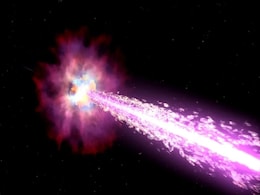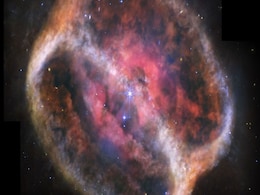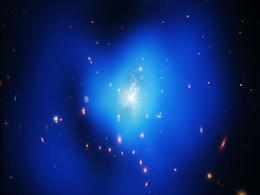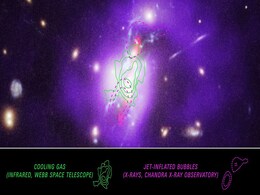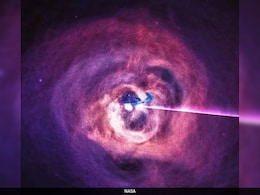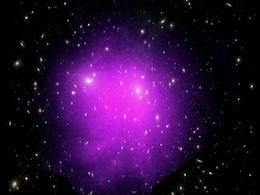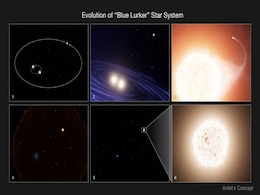Space Clusters
- All
- News
-

New Study Finds Hercules-Corona Borealis Great Wall Bigger and Nearer Than Thought
- Wednesday April 23, 2025
- Written by Gadgets 360 Staff
GRBs uncover a more massive and closer Hercules–Corona Borealis Great Wall, reshaping cosmic scale theories.Astronomers have found that the Hercules–Corona Borealis Great Wall—the largest known structure in the universe—is even larger and closer than previously thought. Spanning 10 billion light-years, this immense cluster of galaxies was t...
-
 www.gadgets360.com
www.gadgets360.com
-

NASA’s James Webb Space Telescope Reveals the Complex Structure of a Planetary Nebula
- Wednesday April 16, 2025
- Written by Gadgets 360 Staff
NASA's James Webb Space Telescope has unveiled the complex character of NGC 1514, a planetary nebula developing over at least 4,000 years. Only seen in infrared light, the nebula's rings now resemble "fuzzy" clusters set in twisted patterns. A network of sharper holes near the centre stars indicates where faster material punched through.
-
 www.gadgets360.com
www.gadgets360.com
-

James Webb Space Telescope Reveals a Stunning Einstein Ring in Hydrus
- Wednesday April 2, 2025
- NDTV
A striking new image from the James Webb Space Telescope reveals an Einstein ring in the Hydrus constellation. The phenomenon occurs when a massive foreground galaxy bends light from a hidden background galaxy, forming a near-perfect ring. This effect, predicted by Einstein’s theory of general relativity, helps astronomers study galaxies from the...
-
 www.gadgets360.com
www.gadgets360.com
-

Hubble Telescope Captures NGC 4536, a Starburst Galaxy with Intense Star Formation
- Wednesday March 26, 2025
- Written by Gadgets 360 Staff
NASA’s Hubble Space Telescope has captured a striking image of NGC 4536, a starburst galaxy 50 million light-years away in the Virgo constellation. The galaxy’s sweeping spiral arms are filled with young blue star clusters and ionized hydrogen gas, indicating rapid star formation. Astronomers believe its bar-like structure channels gas toward t...
-
 www.gadgets360.com
www.gadgets360.com
-

Mysterious Planetary-Mass Objects May Form in Young Star System Clashes
- Wednesday March 12, 2025
- Written by Gadgets 360 Staff
Recent research challenges traditional views on planetary-mass objects, suggesting they may form through violent interactions between young star systems rather than standard planetary or stellar processes. Simulations indicate these clashes create dense gas filaments that evolve into free-floating objects, often in binary pairs. This discovery expl...
-
 www.gadgets360.com
www.gadgets360.com
-

Hubble Captures Stunning Infrared Image of Sh2-284, a Massive Stellar Nursery
- Wednesday March 12, 2025
- Written by Gadgets 360 Staff
Hubble’s latest image of the massive Sh2-284 nebula reveals young stars concealed within thick clouds of gas and dust. Using infrared imaging, astronomers have captured details previously obscured in optical wavelengths. The nebula’s low-metallicity composition provides a glimpse into the conditions of the early universe, shedding light on how ...
-
 www.gadgets360.com
www.gadgets360.com
-

Unexpected Rotational Motion Detected in Ultra-Diffuse Galaxies of Hydra Cluster
- Wednesday March 5, 2025
- Written by Gadgets 360 Staff
Astronomers studying ultra-diffuse galaxies (UDGs) in the Hydra cluster have observed unexpected rotational movement in nearly half of the 30 galaxies examined. Spectroscopic data from the LEWIS programme, using the MUSE instrument on the Very Large Telescope, suggests that gravitational interactions with larger galaxies may influence their formati...
-
 www.gadgets360.com
www.gadgets360.com
-

JWST Identifies Cooling Gas in Phoenix Cluster, Unlocking Star Formation Process
- Thursday February 20, 2025
- Written by Gadgets 360 Staff
The James Webb Space Telescope has detected the missing cooling gas in the Phoenix Cluster, a galaxy cluster located 5.8 billion light-years away. Researchers used the Mid-Infrared Instrument (MIRI) to identify gas at around 540,000 degrees Fahrenheit trapped in cavities within the cluster. This discovery resolves a long-standing mystery of how sta...
-
 www.gadgets360.com
www.gadgets360.com
-

Webb Telescope Unveils Hidden Process Behind Star Formation in Phoenix Cluster
- Friday February 14, 2025
- Written by Gadgets 360 Staff
NASA’s James Webb Space Telescope has uncovered the missing link in star formation within the Phoenix galaxy cluster. By mapping intermediate-temperature gas, researchers identified a crucial phase of cooling that was previously undetected. This discovery explains why the cluster’s supermassive black hole does not fully prevent star formation, ...
-
 www.gadgets360.com
www.gadgets360.com
-

Gravitational Waves Reveal Black Hole Ancestry Through Spin Analysis
- Monday February 3, 2025
- Written by Gadgets 360 Staff
A study published in Physical Review Letters explores how gravitational waves reveal the ancestry of black holes. By examining 69 black hole mergers, researchers found that spin shifts indicate repeated collisions in dense star clusters. This insight supports models suggesting black holes grow through sequential mergers. Observatories like LIGO and...
-
 www.gadgets360.com
www.gadgets360.com
-

Researchers Spot Unusual, Overmassive Globular Clusters in Ultra-Diffuse Galaxy FCC 224
- Friday January 31, 2025
- Written by Gadgets 360 Staff
A new study has uncovered an unexpected globular cluster system in FCC 224, an ultra-diffuse galaxy located in the Fornax cluster. Using data from the Hubble Space Telescope and the Keck Cosmic Web Imager, researchers found that FCC 224 hosts luminous, overmassive globular clusters with unusual properties. The galaxy’s star clusters exhibit narro...
-
 www.gadgets360.com
www.gadgets360.com
-

Hear The Universe Roar: NASA Reveals Haunting Audio From A Supermassive Black Hole
- Tuesday January 28, 2025
- Science | Edited by Nikhil Pandey
NASA has released an eerie audio clip of sound waves emanating from a supermassive black hole in the Perseus galaxy cluster, 250 million light-years away.
-
 www.ndtv.com
www.ndtv.com
-

Coma Cluster’s Distance Closer Than Predicted, Amplifying Hubble Tension Crisis
- Friday January 24, 2025
- Written by Gadgets 360 Staff
A new study led by Dan Scolnic and Adam Riess reveals that the Coma Cluster is 38 million light-years closer than predicted by standard cosmological models, intensifying the ongoing Hubble tension. This discrepancy, involving measurements of type Ia supernova explosions, challenges the universe's expansion rate as predicted by the Hubble–Lemaîtr...
-
 www.gadgets360.com
www.gadgets360.com
-

NASA’s Hubble Observes Rare Blue Lurker Star with Unusual Evolution in M67 Cluster
- Friday January 17, 2025
- Written by Gadgets 360 Staff
NASA’s Hubble Space Telescope has identified a rare stellar phenomenon called the “blue lurker” in the M67 star cluster. Located 2,800 light-years away, this star is part of a triple-star system and has an unusual evolutionary history. The blue lurker’s accelerated spin, taking just four days, contrasts with the typical rotation of Sun-like...
-
 www.gadgets360.com
www.gadgets360.com
-

James Webb and Chandra Capture Images of Star Clusters in Distant Galaxies
- Thursday December 19, 2024
- Written by Gadgets 360 Staff
NASA’s James Webb Space Telescope and Chandra X-ray Observatory have unveiled stunning new images of two star clusters in the Small Magellanic Cloud. NGC 602, located approximately 200,000 light-years from Earth, showcases active star formation, with dust clouds and ionised gas revealing unique stellar birth conditions. Meanwhile, NGC 2264 featur...
-
 www.gadgets360.com
www.gadgets360.com
-

New Study Finds Hercules-Corona Borealis Great Wall Bigger and Nearer Than Thought
- Wednesday April 23, 2025
- Written by Gadgets 360 Staff
GRBs uncover a more massive and closer Hercules–Corona Borealis Great Wall, reshaping cosmic scale theories.Astronomers have found that the Hercules–Corona Borealis Great Wall—the largest known structure in the universe—is even larger and closer than previously thought. Spanning 10 billion light-years, this immense cluster of galaxies was t...
-
 www.gadgets360.com
www.gadgets360.com
-

NASA’s James Webb Space Telescope Reveals the Complex Structure of a Planetary Nebula
- Wednesday April 16, 2025
- Written by Gadgets 360 Staff
NASA's James Webb Space Telescope has unveiled the complex character of NGC 1514, a planetary nebula developing over at least 4,000 years. Only seen in infrared light, the nebula's rings now resemble "fuzzy" clusters set in twisted patterns. A network of sharper holes near the centre stars indicates where faster material punched through.
-
 www.gadgets360.com
www.gadgets360.com
-

James Webb Space Telescope Reveals a Stunning Einstein Ring in Hydrus
- Wednesday April 2, 2025
- NDTV
A striking new image from the James Webb Space Telescope reveals an Einstein ring in the Hydrus constellation. The phenomenon occurs when a massive foreground galaxy bends light from a hidden background galaxy, forming a near-perfect ring. This effect, predicted by Einstein’s theory of general relativity, helps astronomers study galaxies from the...
-
 www.gadgets360.com
www.gadgets360.com
-

Hubble Telescope Captures NGC 4536, a Starburst Galaxy with Intense Star Formation
- Wednesday March 26, 2025
- Written by Gadgets 360 Staff
NASA’s Hubble Space Telescope has captured a striking image of NGC 4536, a starburst galaxy 50 million light-years away in the Virgo constellation. The galaxy’s sweeping spiral arms are filled with young blue star clusters and ionized hydrogen gas, indicating rapid star formation. Astronomers believe its bar-like structure channels gas toward t...
-
 www.gadgets360.com
www.gadgets360.com
-

Mysterious Planetary-Mass Objects May Form in Young Star System Clashes
- Wednesday March 12, 2025
- Written by Gadgets 360 Staff
Recent research challenges traditional views on planetary-mass objects, suggesting they may form through violent interactions between young star systems rather than standard planetary or stellar processes. Simulations indicate these clashes create dense gas filaments that evolve into free-floating objects, often in binary pairs. This discovery expl...
-
 www.gadgets360.com
www.gadgets360.com
-

Hubble Captures Stunning Infrared Image of Sh2-284, a Massive Stellar Nursery
- Wednesday March 12, 2025
- Written by Gadgets 360 Staff
Hubble’s latest image of the massive Sh2-284 nebula reveals young stars concealed within thick clouds of gas and dust. Using infrared imaging, astronomers have captured details previously obscured in optical wavelengths. The nebula’s low-metallicity composition provides a glimpse into the conditions of the early universe, shedding light on how ...
-
 www.gadgets360.com
www.gadgets360.com
-

Unexpected Rotational Motion Detected in Ultra-Diffuse Galaxies of Hydra Cluster
- Wednesday March 5, 2025
- Written by Gadgets 360 Staff
Astronomers studying ultra-diffuse galaxies (UDGs) in the Hydra cluster have observed unexpected rotational movement in nearly half of the 30 galaxies examined. Spectroscopic data from the LEWIS programme, using the MUSE instrument on the Very Large Telescope, suggests that gravitational interactions with larger galaxies may influence their formati...
-
 www.gadgets360.com
www.gadgets360.com
-

JWST Identifies Cooling Gas in Phoenix Cluster, Unlocking Star Formation Process
- Thursday February 20, 2025
- Written by Gadgets 360 Staff
The James Webb Space Telescope has detected the missing cooling gas in the Phoenix Cluster, a galaxy cluster located 5.8 billion light-years away. Researchers used the Mid-Infrared Instrument (MIRI) to identify gas at around 540,000 degrees Fahrenheit trapped in cavities within the cluster. This discovery resolves a long-standing mystery of how sta...
-
 www.gadgets360.com
www.gadgets360.com
-

Webb Telescope Unveils Hidden Process Behind Star Formation in Phoenix Cluster
- Friday February 14, 2025
- Written by Gadgets 360 Staff
NASA’s James Webb Space Telescope has uncovered the missing link in star formation within the Phoenix galaxy cluster. By mapping intermediate-temperature gas, researchers identified a crucial phase of cooling that was previously undetected. This discovery explains why the cluster’s supermassive black hole does not fully prevent star formation, ...
-
 www.gadgets360.com
www.gadgets360.com
-

Gravitational Waves Reveal Black Hole Ancestry Through Spin Analysis
- Monday February 3, 2025
- Written by Gadgets 360 Staff
A study published in Physical Review Letters explores how gravitational waves reveal the ancestry of black holes. By examining 69 black hole mergers, researchers found that spin shifts indicate repeated collisions in dense star clusters. This insight supports models suggesting black holes grow through sequential mergers. Observatories like LIGO and...
-
 www.gadgets360.com
www.gadgets360.com
-

Researchers Spot Unusual, Overmassive Globular Clusters in Ultra-Diffuse Galaxy FCC 224
- Friday January 31, 2025
- Written by Gadgets 360 Staff
A new study has uncovered an unexpected globular cluster system in FCC 224, an ultra-diffuse galaxy located in the Fornax cluster. Using data from the Hubble Space Telescope and the Keck Cosmic Web Imager, researchers found that FCC 224 hosts luminous, overmassive globular clusters with unusual properties. The galaxy’s star clusters exhibit narro...
-
 www.gadgets360.com
www.gadgets360.com
-

Hear The Universe Roar: NASA Reveals Haunting Audio From A Supermassive Black Hole
- Tuesday January 28, 2025
- Science | Edited by Nikhil Pandey
NASA has released an eerie audio clip of sound waves emanating from a supermassive black hole in the Perseus galaxy cluster, 250 million light-years away.
-
 www.ndtv.com
www.ndtv.com
-

Coma Cluster’s Distance Closer Than Predicted, Amplifying Hubble Tension Crisis
- Friday January 24, 2025
- Written by Gadgets 360 Staff
A new study led by Dan Scolnic and Adam Riess reveals that the Coma Cluster is 38 million light-years closer than predicted by standard cosmological models, intensifying the ongoing Hubble tension. This discrepancy, involving measurements of type Ia supernova explosions, challenges the universe's expansion rate as predicted by the Hubble–Lemaîtr...
-
 www.gadgets360.com
www.gadgets360.com
-

NASA’s Hubble Observes Rare Blue Lurker Star with Unusual Evolution in M67 Cluster
- Friday January 17, 2025
- Written by Gadgets 360 Staff
NASA’s Hubble Space Telescope has identified a rare stellar phenomenon called the “blue lurker” in the M67 star cluster. Located 2,800 light-years away, this star is part of a triple-star system and has an unusual evolutionary history. The blue lurker’s accelerated spin, taking just four days, contrasts with the typical rotation of Sun-like...
-
 www.gadgets360.com
www.gadgets360.com
-

James Webb and Chandra Capture Images of Star Clusters in Distant Galaxies
- Thursday December 19, 2024
- Written by Gadgets 360 Staff
NASA’s James Webb Space Telescope and Chandra X-ray Observatory have unveiled stunning new images of two star clusters in the Small Magellanic Cloud. NGC 602, located approximately 200,000 light-years from Earth, showcases active star formation, with dust clouds and ionised gas revealing unique stellar birth conditions. Meanwhile, NGC 2264 featur...
-
 www.gadgets360.com
www.gadgets360.com

